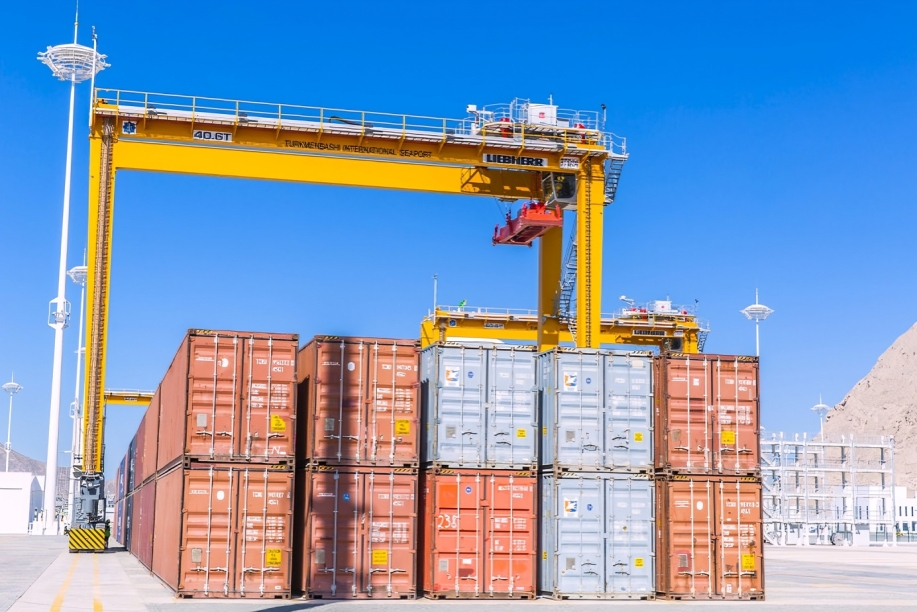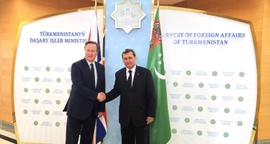As many as 52 container trains passed through the territory of Turkmenistan in the directions of Uzbekistan-Azerbaijan-Georgia and Russia-Kazakhstan-Iran in 2023.
“During the year, 10,799 container shipments were carried out in the country, including 5,614 transit, 2,316 export and 2,869 import. Overall, this is 356 more container shipments than in 2022,” Turkmen news website Orient.tm reported on January 21.
"Turkmenistan and its partners are actively working on developing the multimodal transport corridor China-Kyrgyzstan-Uzbekistan-Turkmenistan-Azerbaijan-Georgia-Türkiye-Europe. At present, new cargo shipments are being organised along the Uzbekistan-Turkmenistan-Iran-Oman transit corridor, as well as container transportation along the China-Tajikistan-Uzbekistan-Turkmenistan-Iran-Türkiye route," the report added.
Turkmenistan, together with its partners, is creating an extensive system of transport and logistics chains in the East-West, North-South directions. This system will also connect the regions of the Caspian, Black and Baltic Seas in the future.
Ashgabat makes efforts to implement the relevant TRACECA documents aimed at expanding the investment potential of railway corridors along the routes “Asia-Europe”, “Europe-Middle East”, “Lapis Lazuli Corridor”, “Caspian Sea-Black Sea”.
There is a container terminal on the Turkmenbashi International Seaport, located along the international transit corridors “Lapis Lazuli” and Europe-Caucasus-Asia (TRACECA), which is engaged in the transit of goods arriving by rail, road and air transport. The terminal has all facilities for handling 400,000 of containers annually.
The existing sea routes connect the Turkmenbashi port with the ports of Baku (Azerbaijan), Astrakhan and Makhachkala (Russia), Aktau (Kazakhstan), Enzeli, Nowshahr, Bandar-Turkmen (Iran) and other ports.
Ongoing efforts focus on boosting cargo flows along the Uzbekistan-Turkmenistan-Iran-Oman transit route and increasing container traffic on the China-Tajikistan-Uzbekistan-Turkmenistan-Iran-Türkiye route.
The railway route along the Türkiye-Iran-Turkmenistan-Uzbekistan corridor launched in December 2022, with the first freight train of 40 wagons loaded with household appliances from Izmir to Tashkent. The length of the route was over 4,500 kilometers.
The railway authorities of Kazakhstan and Turkmenistan systematically lower the fares of the Kazakhstan-Turkmenistan-Iran railway corridor, in order to increase the logistics attractiveness of the route.
In November 2022, the Russian, Kazakh and Turkmen railways and logistics companies signed a document on international and transit freight transportation. The sides agreed to develop a joint railway service on the International North-South Transport Corridor (INSTC) using the transport and logistics infrastructure, to ensure regular freight traffic and boost the international import-export flow of goods.
In October 2022, the Russian Railways Logistics company started transportation of full-composite container trains from Russia to Iran on the eastern branch of the North-South land corridor using the transport infrastructure of Turkmenistan.
Currently, the main flow of cargo along the INSTC in Turkmenistan passes through the southern border crossing with Iran at Sarakhs. But there is also the Akayla (Turkmenistan)-Inche Burun (Iran) crossing in the west, which can increase transit volumes.
The INSTC is a multimodal network spanning 7,200 kilometers of ship, rail, and road routes. It is designed to provide the shortest multi-modal transportation route linking the Indian Ocean and the Persian Gulf to the Caspian and Baltic seas.







 Kyrgyzstan has joined the extensive reconstruction efforts in the Karabakh region of Azerbaijan, after a series of mega initiatives were launched b...
Kyrgyzstan has joined the extensive reconstruction efforts in the Karabakh region of Azerbaijan, after a series of mega initiatives were launched b...
 President Ilham Aliyev shed light on the evolving contours of the peace process with Armenia during an international conference in Baku this week. ...
President Ilham Aliyev shed light on the evolving contours of the peace process with Armenia during an international conference in Baku this week. ...
 Azerbaijan and Armenia started the process of demarcation of their border on Tuesday, with the installation of the first border markers based on ge...
Azerbaijan and Armenia started the process of demarcation of their border on Tuesday, with the installation of the first border markers based on ge...
 Iran and Pakistan have signed eight cooperation documents in various fields, and agreed to strengthen ties to fight terrorism in the region.
Iran and Pakistan have signed eight cooperation documents in various fields, and agreed to strengthen ties to fight terrorism in the region.
 Iranian President Ebrahim Raisi expressed Tehran’s readiness to participate in significant development projects in Sri Lanka during the inauguratio...
Iranian President Ebrahim Raisi expressed Tehran’s readiness to participate in significant development projects in Sri Lanka during the inauguratio...
 As the conflict between Ukraine and Russia escalates, the strategic importance of Kharkiv, Ukraine's second-largest city, has come sharply into focus.
As the conflict between Ukraine and Russia escalates, the strategic importance of Kharkiv, Ukraine's second-largest city, has come sharply into focus.



